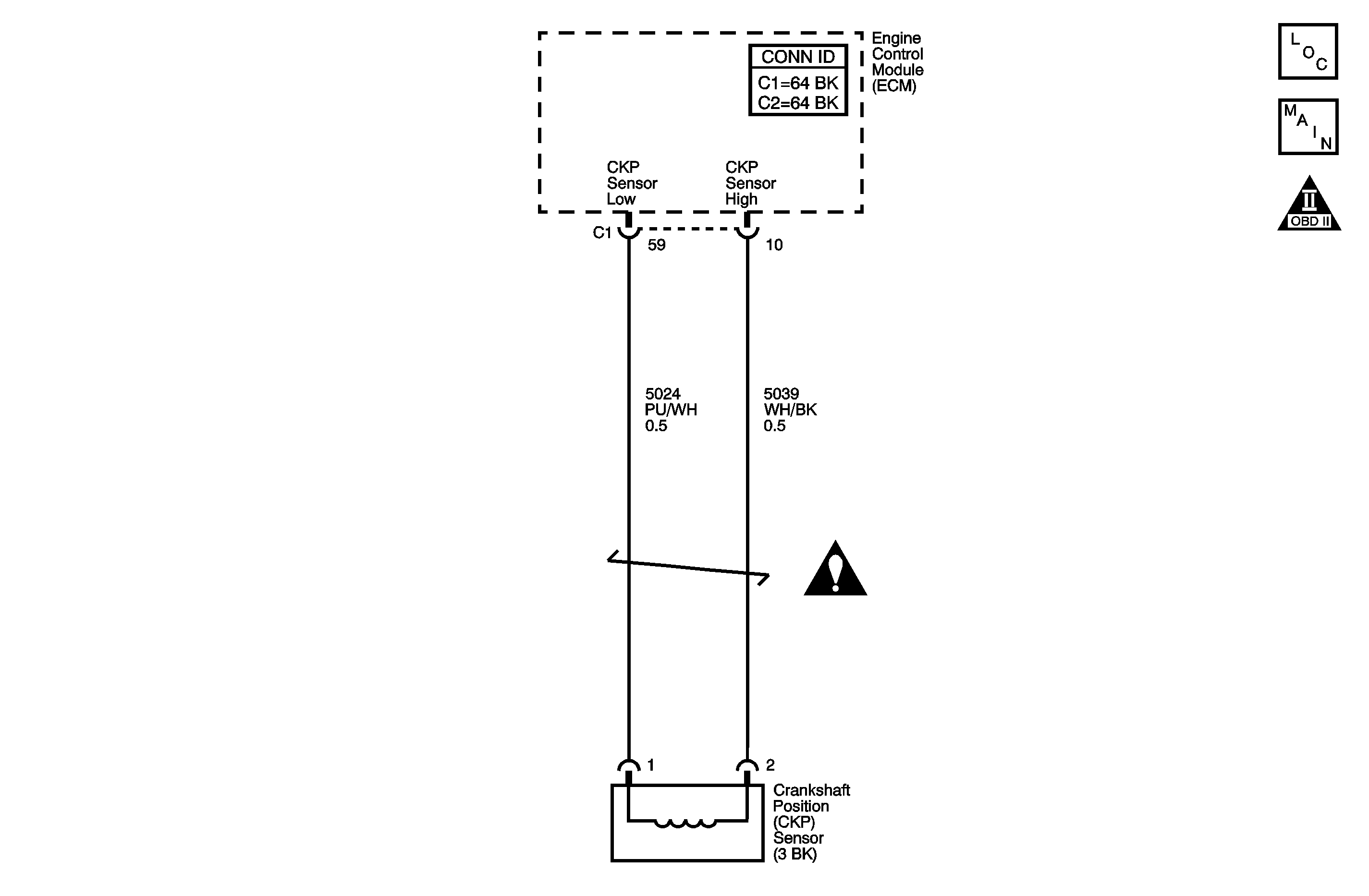
Circuit Description
The crankshaft position (CKP) sensor is a variable reluctance sensor. The CKP sensor indicates the crankshaft speed and position. The CKP sensor produces an AC voltage of different amplitude and frequency. The frequency depends on the velocity of the crankshaft. The AC voltage output depends on the CKP and battery voltage. The engine control module (ECM) uses a pull-up voltage of 2.5 volts on each CKP sensor circuit for reduction of noise interference from electromagnetic generating devices. The CKP sensor works in conjunction with a 58-tooth reluctor wheel on the crankshaft. The CKP sensor connects to the ECM through the following circuits:
| • | A CKP sensor high circuit |
| • | A CKP sensor low circuit |
If the ECM detects no sync pulse, DTC P0336 sets.
Conditions for Running the DTC
DTCs P0341, P0342, P0343 are not set.
The engine is cranking or running.
Conditions for Setting the DTC
The ECM has detected no sync pulse.
Action Taken When the DTC Sets
| • | The control module illuminates the malfunction indicator lamp (MIL) on the second consecutive ignition cycle that the diagnostic runs and fails. |
| • | The control module records the operating conditions at the time the diagnostic fails. The first time the diagnostic fails, the control module stores this information in the Failure Records. If the diagnostic reports a failure on the second consecutive ignition cycle, the control module records the operating conditions at the time of the failure. The control module writes the operating conditions to the Freeze Frame and updates the Failure Records. |
Conditions for Clearing the MIL/DTC
| • | The control module turns OFF the malfunction indicator lamp (MIL) after 3 consecutive ignition cycles that the diagnostic runs and does not fail. |
| • | A current DTC, Last Test Failed, clears when the diagnostic runs and passes. |
| • | A history DTC clears after 40 consecutive warm-up cycles, if no failures are reported by this or any other emission related diagnostic. |
| • | Clear the MIL and the DTC with a scan tool. |
Test Description
The numbers below refer to the step numbers on the diagnostic table.
-
This step tests for an internally shorted sensor.
-
This step tests for electromagnetic interference on the CKP circuits.
Step | Action | Value | Yes | No | ||||||||||||
|---|---|---|---|---|---|---|---|---|---|---|---|---|---|---|---|---|
Schematic Reference: Engine Controls Schematics Connector End View Reference: Engine Control Module Connector End Views or Engine Controls Connector End Views | ||||||||||||||||
1 | Did you perform the Diagnostic System Check-Engine Controls? | -- | Go to Step 2 | |||||||||||||
2 | Attempt to start the engine. Does the engine start and run? | -- | Go to Step 3 | Go to Step 4 | ||||||||||||
3 |
Did the DTC fail this ignition? | -- | Go to Step 4 | Go to Intermittent Conditions | ||||||||||||
Is the resistance within the specified range? | 800-1200 ohms | Go to Step 5 | Go to Step 10 | |||||||||||||
Inspect the harness of the CKP sensor for incorrect routing that is too close to the following components:
Did you find and correct the condition? | -- | Go to Step 14 | Go to Step 6 | |||||||||||||
6 | Test the high circuit of the CKP sensor for an intermittent condition. Refer to Inducing Intermittent Fault Conditions and Testing for Electrical Intermittents in Wiring Systems. Did you find and correct the condition? | -- | Go to Step 14 | Go to Step 7 | ||||||||||||
7 | Test the low circuit of the CKP sensor for an intermittent condition. Refer to Inducing Intermittent Fault Conditions and Testing for Electrical Intermittents in Wiring Systems. Did you find and correct the condition? | -- | Go to Step 14 | Go to Step 8 | ||||||||||||
8 | Test for an intermittent and for a poor connection at the CKP sensor. Refer to Testing for Intermittent Conditions and Poor Connections and Wiring Repairs in Wiring Systems. Did you find and correct the condition? | -- | Go to Step 14 | Go to Step 9 | ||||||||||||
9 | Test for an intermittent and for a poor connection at the engine control module (ECM). Refer to Testing for Intermittent Conditions and Poor Connections and Wiring Repairs in Wiring Systems. Did you find and correct the condition? | -- | Go to Step 14 | Go to Step 13 | ||||||||||||
10 | Remove the CKP sensor. Refer to Crankshaft Position Sensor Replacement . Visually inspect the CKP sensor for the following conditions:
Did you find and correct the condition? | -- | Go to Step 14 | Go to Step 11 | ||||||||||||
11 | Inspect the CKP reluctor wheel for the following conditions:
Refer to Crankshaft and Bearing Cleaning and Inspection in Engine Mechanical. Did you find and correct the condition? | -- | Go to Step 14 | Go to Step 12 | ||||||||||||
12 | Replace the CKP sensor. Refer to Crankshaft Position Sensor Replacement . Did you complete the replacement? | -- | Go to Step 14 | -- | ||||||||||||
13 | Replace the ECM. Refer to Engine Control Module Replacement . Did you complete the replacement? | -- | Go to Step 14 | -- | ||||||||||||
14 | Clear the DTCs with a scan tool. Turn OFF the ignition for 30 seconds. Start the engine. Operate the vehicle within the Conditions for Running the DTC. You may also operate the vehicle within the conditions that you observed from the Freeze/Frame Failure Records. Did the DTC fail this ignition? | -- | Go to Step 2 | Go to Step 15 | ||||||||||||
15 | Observe the Capture Info with a scan tool. Are there any DTCs that have not been diagnosed? | -- | System OK | |||||||||||||
